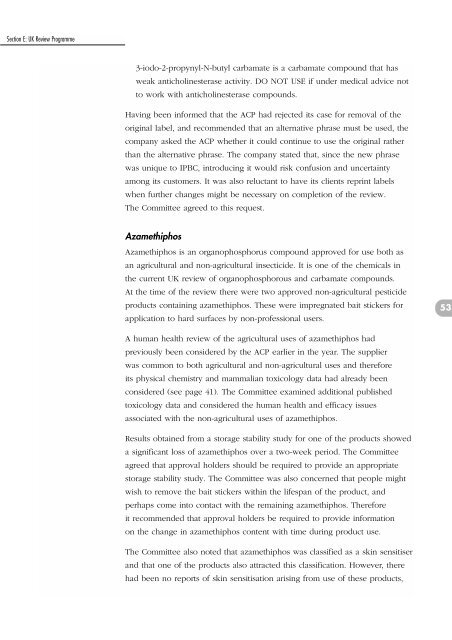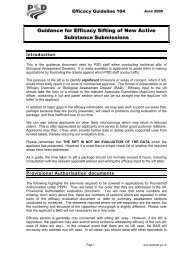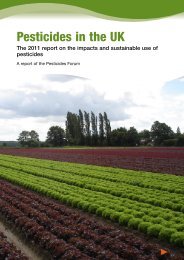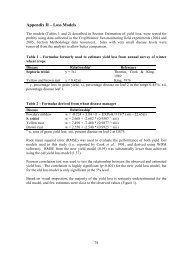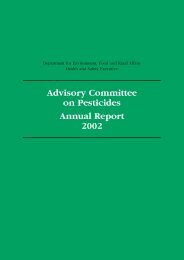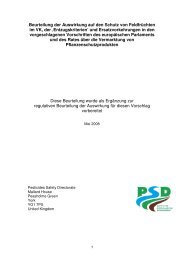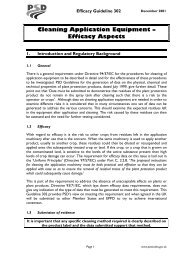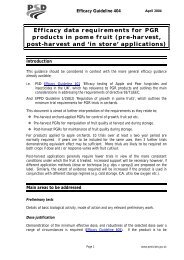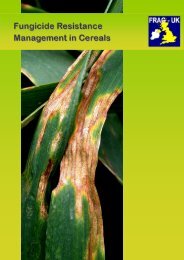Advisory Committee on Pesticides Annual Report 2001
ACP Annual Report 2001 - Pesticides Safety Directorate
ACP Annual Report 2001 - Pesticides Safety Directorate
Create successful ePaper yourself
Turn your PDF publications into a flip-book with our unique Google optimized e-Paper software.
Secti<strong>on</strong> E: UK Review Programme<br />
3-iodo-2-propynyl-N-butyl carbamate is a carbamate compound that has<br />
weak anticholinesterase activity. DO NOT USE if under medical advice not<br />
to work with anticholinesterase compounds.<br />
Having been informed that the ACP had rejected its case for removal of the<br />
original label, and recommended that an alternative phrase must be used, the<br />
company asked the ACP whether it could c<strong>on</strong>tinue to use the original rather<br />
than the alternative phrase. The company stated that, since the new phrase<br />
was unique to IPBC, introducing it would risk c<strong>on</strong>fusi<strong>on</strong> and uncertainty<br />
am<strong>on</strong>g its customers. It was also reluctant to have its clients reprint labels<br />
when further changes might be necessary <strong>on</strong> completi<strong>on</strong> of the review.<br />
The <str<strong>on</strong>g>Committee</str<strong>on</strong>g> agreed to this request.<br />
Azamethiphos<br />
Azamethiphos is an organophosphorus compound approved for use both as<br />
an agricultural and n<strong>on</strong>-agricultural insecticide. It is <strong>on</strong>e of the chemicals in<br />
the current UK review of organophosphorous and carbamate compounds.<br />
At the time of the review there were two approved n<strong>on</strong>-agricultural pesticide<br />
products c<strong>on</strong>taining azamethiphos. These were impregnated bait stickers for<br />
applicati<strong>on</strong> to hard surfaces by n<strong>on</strong>-professi<strong>on</strong>al users.<br />
53<br />
A human health review of the agricultural uses of azamethiphos had<br />
previously been c<strong>on</strong>sidered by the ACP earlier in the year. The supplier<br />
was comm<strong>on</strong> to both agricultural and n<strong>on</strong>-agricultural uses and therefore<br />
its physical chemistry and mammalian toxicology data had already been<br />
c<strong>on</strong>sidered (see page 41). The <str<strong>on</strong>g>Committee</str<strong>on</strong>g> examined additi<strong>on</strong>al published<br />
toxicology data and c<strong>on</strong>sidered the human health and efficacy issues<br />
associated with the n<strong>on</strong>-agricultural uses of azamethiphos.<br />
Results obtained from a storage stability study for <strong>on</strong>e of the products showed<br />
a significant loss of azamethiphos over a two-week period. The <str<strong>on</strong>g>Committee</str<strong>on</strong>g><br />
agreed that approval holders should be required to provide an appropriate<br />
storage stability study. The <str<strong>on</strong>g>Committee</str<strong>on</strong>g> was also c<strong>on</strong>cerned that people might<br />
wish to remove the bait stickers within the lifespan of the product, and<br />
perhaps come into c<strong>on</strong>tact with the remaining azamethiphos. Therefore<br />
it recommended that approval holders be required to provide informati<strong>on</strong><br />
<strong>on</strong> the change in azamethiphos c<strong>on</strong>tent with time during product use.<br />
The <str<strong>on</strong>g>Committee</str<strong>on</strong>g> also noted that azamethiphos was classified as a skin sensitiser<br />
and that <strong>on</strong>e of the products also attracted this classificati<strong>on</strong>. However, there<br />
had been no reports of skin sensitisati<strong>on</strong> arising from use of these products,


